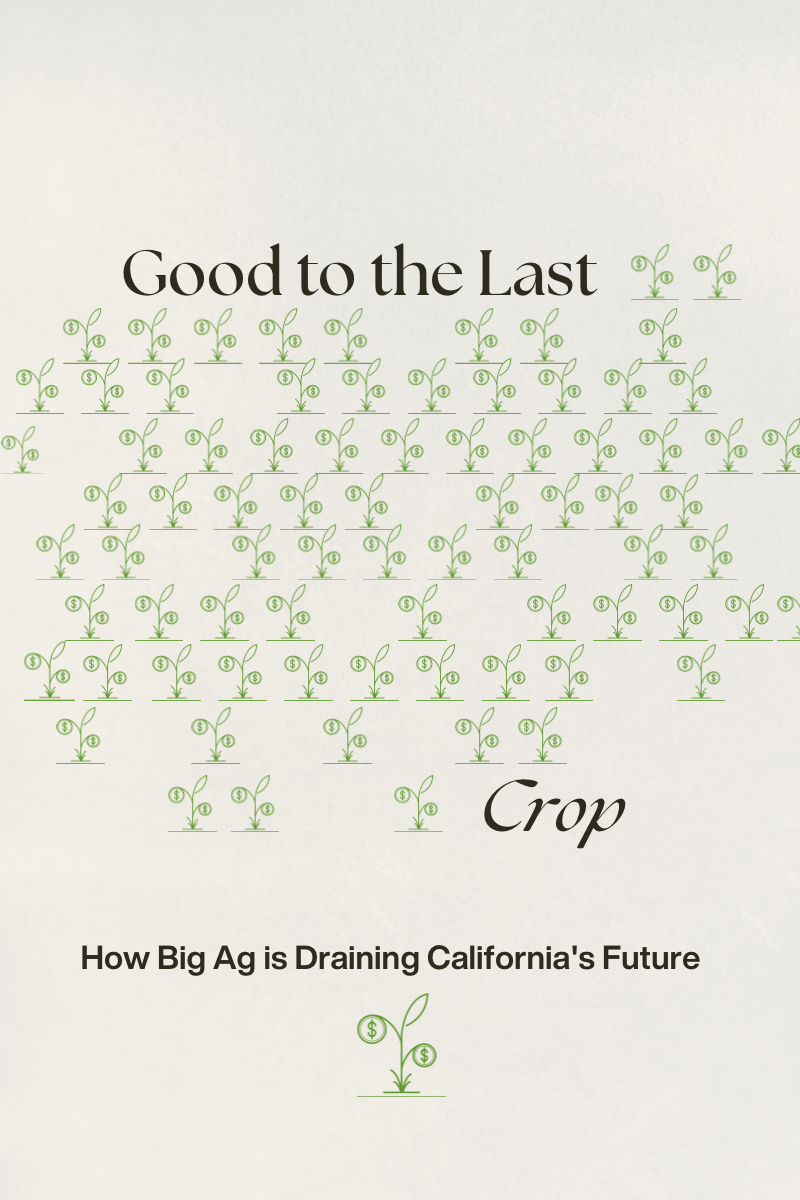The Delta Dilemma: California's Water Crisis Epicenter

The San Joaquin Delta—once a thriving estuary where freshwater and saltwater mixed to create one of North America's most biodiverse ecosystems—is now a cautionary tale. As documented in the eye-opening film "The River's End," this vital waterway has been slowly strangled by decades of damming, diversion, and domination by agricultural interests.
What many Californians don't realize is the stark imbalance in how our most precious resource is allocated:
Agriculture accounts for only 4% of California's GDP but consumes a staggering 40% of the state's water supply.
Let that sink in. Nearly half our water goes to an industry that contributes minimally to our economy—and much of what that water produces doesn't even
Following the Flow: Where California's Water Really Goes
The math doesn't add up when you look at who benefits from our water policies. Major agricultural corporations—including giants like Cargill, The Wonderful Company, and Blue Diamond Almonds—have built empires on crops that require enormous amounts of water, often in regions that were never meant to support such intensive farming.
Source: Pacific Institute, California Water Research
The Wonderful Company, owned by billionaires Stewart and Lynda Resnick, has built a fortune on pistachios and almonds—some of the most water-intensive crops possible. During drought years, while residential users face restrictions and natural systems collapse, their orchards continue to receive water through preferential access and water rights that date back to the early 20th century.
Meanwhile, Blue Diamond Almonds coordinates the production of over 80% of the world's almond supply, much of it grown in California's Central Valley. A single almond requires approximately 1.1 gallons of water to produce. With California exporting over 70% of its almond crop, we're essentially exporting billions of gallons of our water overseas each year.
The True Cost: Environmental Devastation
The consequences of our misaligned water priorities extend far beyond simple resource allocation:
1. Collapsing Ecosystems: Native fish populations in the Delta, including Chinook salmon and Delta smelt, have plummeted by over 90%.
2. Groundwater Depletion: Excessive pumping has caused parts of the Central Valley to sink by as much as 28 feet in some areas, permanently reducing aquifer capacity.
3. Toxic Runoff: Agricultural chemicals flow back into our waterways, creating toxic conditions for wildlife and contaminating drinking water sources.
4. Climate Vulnerability: As climate change intensifies drought cycles, our overtaxed water system has less resilience against increasingly unpredictable weather patterns.
Many of California's most iconic outdoor destinations—from Mount Shasta to the Eastern Sierra—are directly impacted by these water policies.

Beyond Awareness: Taking Action
Understanding the problem is just the first step. Here's what you can do to help shift the balance:
Immediate Actions
- Vote with Your Fork: Reduce consumption of water-intensive crops, especially almonds, pistachios, and beef. When possible, choose locally-grown food over exports.
- Monitor Water Politics: Follow and support organizations like Restore the Delta, the Sierra Club California, and Water Protectors that advocate for better water policies.
- Use Your Voice: Contact your state representatives about reforming California's archaic water rights system that gives preference to agricultural corporations over environmental needs.
Community Initiatives
- Join Watershed Restoration Projects: Organizations throughout California coordinate volunteer opportunities to restore riparian habitats.
- Organize Educational Events: As outdoor athletes, we can use our platforms to raise awareness about water issues at competitions, film festivals, and community gatherings.
- Support Sustainable Farmers: Seek out and support farms using dry-farming techniques, cover cropping, and other water-wise practices.
Systemic Change
- Advocate for Water Rights Reform: California's current "first in time, first in right" water allocation system needs comprehensive reform to prioritize sustainable use.
- Push for Transparent Water Trading: Corporate water trading happens with minimal public oversight. We need transparency in how water rights are bought and sold.
- Demand Agricultural Transition Support: Support policies that help farmers transition from water-intensive crops to more sustainable alternatives.
A Call to the Outdoor Community
As outdoor enthusiasts who live for powder days, alpine starts, and singletrack descents, we have a unique stake in California's water future. We see firsthand how changing precipitation patterns affect our mountains. We notice when rivers run low or when algal blooms make lakes untouchable.
The corporations extracting profit from California's water aren't necessarily evil—they're simply operating within a broken system that allows them to externalize the true costs of their operations onto our environment and communities.
But we have the power to change that system. Through our collective voices, consumer choices, and political engagement, we can push California toward a water future that balances agricultural needs with environmental sustainability.
The San Joaquin Delta, and all the watersheds that feed our mountains and valleys, don't have to be sacrificed on the altar of agricultural exports. We can create a different story—one where California leads the way in sustainable water management just as it has led in so many other environmental initiatives.
Our outdoor playgrounds depend on it. Our communities depend on it. And ultimately, our future in this beautiful, contradictory state depends on it.
#RealTalk
🌾 Should countries like Saudi Arabia be allowed to lease farmland in drought states like California and Arizona?
With the recent fires in LA, the long albeit unsuccessful battle over water rights is still being debated without any real solutions in the foreseeable future.
I recently watched The River’s End documentary and was shocked to learn about how much control Big Ag has over California water, yet only 4% of agriculture accounts for the state GDP.
For decades companies like Almarai have leased farmland to grow Alfalfa (a highly water intensive crop), that is exported back to Saudi Arabia to feed their cattle…essentially buying water in the form of Alfalfa in states like California and Arizona. It’s also worth noting that Saudi Arabia has banned growing crops like Alfalfa due to its high water usage.
Of all the reasons why we need water policy reform, this was the most obvious one. As the climate crisis pushes us far beyond the breaking point into 3°C range, at what point will we start conserving the water we have left?
If you found this article insightful, like share or follow @ArticlesInCommon and @wildforclimate for more topics at the intersection of outdoor sports and climate action.
What actions are you taking in your local community to address California's water crisis? Share your experiences and ideas in the comments below.
#CaliforniaWater #ClimateAction #OutdoorAthletes #SanJoaquinDelta #WaterRights #SustainableAgriculture #DroughtResponse









